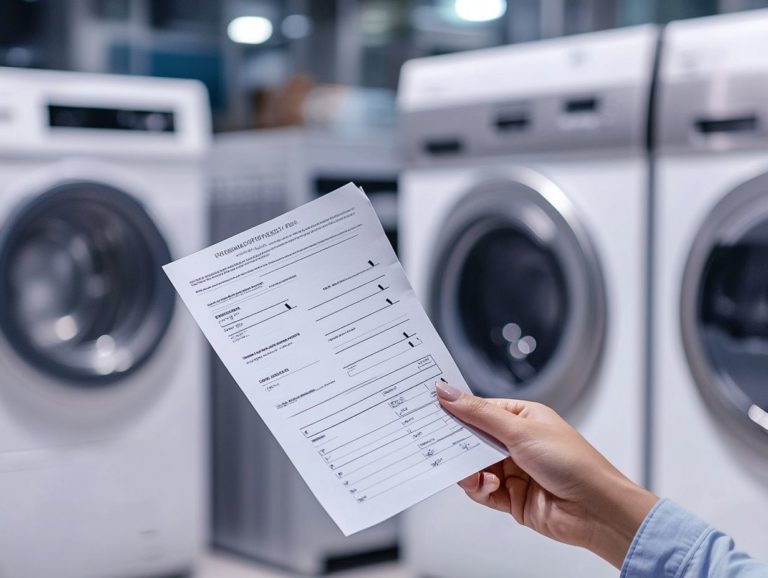What to Keep in Mind When Purchasing a Warranty?
Warranties serve as a valuable safeguard for your purchases, providing you with peace of mind and financial protection. However, navigating the world of warranties can be a bit tricky.
Let s explore what a warranty really is and how it can protect you! This article discusses the different types of warranties available, highlights important factors to consider before making a purchase, addresses common pitfalls to avoid, and shares tips to help you maximize the benefits of your warranty.
By the end, you ll be fully equipped to make informed decisions and effectively protect your investments.
Contents
Key Takeaways:

- Consider coverage and duration when purchasing a warranty; it should match your needs and the lifespan of the product.
- Be aware of the cost and value of a warranty, as a higher price does not always equate to better coverage.
- Avoid common pitfalls such as overlooking fine print and unnecessary coverage. Make the most of your warranty by properly maintaining your product and understanding your rights and responsibilities.
Understanding Warranties
Understanding warranties is important for both homeowners and vehicle owners, as they offer important financial protection against unexpected breakdowns and repairs. This knowledge gives you peace of mind when dealing with the often substantial costs tied to HVAC units, appliances, and vehicles.
In today’s marketplace, extended warranties have gained significant attention for their ability to safeguard your investments, especially when they come from reputable providers like JB Warranties.
What is a Warranty?
A warranty functions as your safety net a promise from a warranty provider to cover repairs or replacements for specific products, offering you essential financial protection.
This assurance can lift the weight of unexpectedly high repair costs off your shoulders, providing you with peace of mind, especially if you rely heavily on your appliances, electronics, and vehicles. Understanding how warranties operate is crucial, as they differ significantly in terms of coverage, duration, and limitations.
Typically, you ll encounter two primary types of warranties:
- Manufacturer warranties, which come at no extra cost and cover defects in workmanship or materials.
- Original equipment manufacturer (OEM) warranties, which are provided by the product’s manufacturer and cover defects.
- Extended warranties, which you can purchase to extend protection beyond the original coverage period.
Each option has its own conditions and benefits, making it vital for you to carefully assess your choices to ensure you select the coverage that best suits your needs.
Types of Warranties
You ll find a variety of warranties available on the market, including OEM warranties, aftermarket warranties, extended warranties, and specialized service contracts designed to meet diverse consumer needs across appliances, vehicles, and HVAC systems.
Understanding these options is important if you want peace of mind and protection against unexpected costs. OEM warranties cover factory defects and ensure a perfect fit with your product. Alternatively, aftermarket warranties often offer broader coverage options at competitive prices, though they may come with limited service networks.
Extended warranties give you extra security beyond the original coverage, making them particularly beneficial for items that are prone to wear and tear. Meanwhile, specialized service contracts provide tailored solutions for specific systems, proving invaluable for those looking to protect critical components in their homes or vehicles.
Factors to Consider When Purchasing a Warranty
When you re considering the purchase of a warranty, it s essential to weigh several key factors. Think about the coverage limits, warranty duration, costs, and deductible amounts. A deductible is the amount you pay out of pocket before your warranty kicks in.
Each of these elements plays a crucial role in shaping the overall value you receive and the peace of mind that comes with the warranty s benefits.
Coverage and Duration

The coverage and duration of a warranty are key factors that determine the level of financial protection you receive against repairs and replacements.
Understanding the various types of coverage available can significantly enhance your protection. Options like comprehensive coverage don t just shield you from mechanical failures; they also encompass accidental damage and wear and tear. This broader scope of protection provides peace of mind, ensuring you won t be left facing hefty out-of-pocket expenses.
The duration of the warranty is also important for your satisfaction and value; the longer a warranty lasts, the more confidence it instills. This makes it a critical consideration when looking at different products. By carefully examining both the types of coverage and their durations, you can make informed choices that align perfectly with your needs and budget.
Cost and Value
Understanding the costs associated with warranties is crucial for you as a consumer. It allows you to assess their value and make informed decisions about your warranty investment, especially when potential financial concerns are at play.
Several factors significantly influence these costs, including the type of product, the duration of coverage, and past repair rates. Your perception of a warranty’s value often relies on the level of customer satisfaction it delivers; you re likely to feel more secure in your purchase when you believe your financial protection is solid.
By analyzing trends in warranty claims, you can gain insight into how effectively these costs align with overall product reliability. This information enables you to weigh the benefits against the risks in a thoughtful and balanced manner.
Terms and Conditions
The terms and conditions of a warranty often dictate the claims processes the steps you take to request coverage under your warranty and coverage limits, making it essential for you to grasp these elements to avoid customer objections later.
Neglecting to thoroughly review warranty terms can lead to misunderstandings, frustrating both you and your customers. Many customers miss key exclusions or conditions that can affect their claims, leading to unexpected denials.
Transparent contracts are crucial not just for clarity but also for building trust between all parties involved. By engaging in a detailed examination of these documents, you can navigate potential pitfalls more effectively and foster a smoother relationship with service providers, ensuring that everyone’s rights and responsibilities are clearly outlined and respected.
Common Pitfalls to Avoid
As you navigate the warranty landscape, you may find yourself facing typical pitfalls, such as misinterpretations of fine print, overlooked exclusions, and the risk of ending up with unnecessary or duplicate coverage. These missteps can complicate your claims process significantly.
Fine Print and Exclusions
The fine print and exclusions in warranty agreements can greatly affect your ability to utilize the service, often leading to challenges during the claims process.
It s crucial for you to take the time to thoroughly review these documents to steer clear of pitfalls that could result in financial loss or denied claims. For example, many warranties exclude coverage for certain types of damage, like wear and tear, or don t cover repairs made by unauthorized individuals. You might also find stipulations about how quickly you need to file a claim after an incident, which can catch you off guard.
Understanding these nuances not only helps you make informed decisions but also enables you to advocate effectively for your rights when issues arise.
Unnecessary or Duplicate Coverage

Many consumers fall into the trap of purchasing unnecessary or duplicate coverage. This results in money down the drain and confusion about available warranty options.
To identify unnecessary or duplicate coverage, carefully review your existing policies. Clearly understanding what is already covered under various warranties is essential.
Start by compiling all your current insurance, warranty, and service contracts to spot overlapping benefits. For example, if a home appliance is already protected under a manufacturer s warranty, acquiring additional coverage may be redundant and ultimately a drain on your finances.
Understanding these implications helps you manage your budget more effectively. It also ensures you’re not unknowingly exposed to risks that you believe are covered.
This approach promotes better financial health and grants you valuable peace of mind.
Tips for Making the Most of Your Warranty
To truly maximize the benefits of a warranty, engage in regular care and fully understand your rights and responsibilities. This ensures you can communicate effectively with warranty companies and repair facilities, paving the way for a seamless experience when the need arises.
Proper Maintenance and Care
Properly maintaining your appliances and heating, ventilation, and air conditioning systems not only extends their lifespan but also minimizes repair costs. Ultimately, this maximizes the benefits of your warranties.
When you invest in high-quality products, it s easy to overlook the importance of routine upkeep. Regular maintenance acts as a critical safeguard, ensuring that your appliances operate at peak performance.
Neglecting these essential practices can lead to voided warranties, leaving you exposed to unexpected repair expenses. By recognizing the connection between consistent maintenance and warranty preservation, you can better protect your financial investments.
Enhancing the longevity and efficiency of your vital household equipment is key.
Understanding Your Rights and Responsibilities
Understanding your rights and responsibilities as a consumer is crucial for navigating warranty claims processes effectively. This ensures you make the most of your warranty benefits.
Being well-informed helps you manage expectations and enables you to take decisive action when issues arise. For example, knowing that most warranties cover defects in materials and workmanship can help you identify valid claims.
It s equally important to recognize the need to provide proof of purchase and adhere to specific procedures. For instance, reporting issues in a timely manner is essential.
By staying informed about the terms and conditions, you can advocate for yourself with confidence. This includes communicating directly with manufacturers or escalating claims when necessary.
Frequently Asked Questions
What Should I Keep in Mind When Purchasing a Warranty?

Before purchasing a warranty, consider several factors to ensure you get the best coverage for your needs.
Why Get a Warranty?
A warranty provides protection against defects or malfunctions in a product. It can cover the cost of repairs or replacements within a specified time frame.
What Type of Warranty Should I Look For?
There are different types of warranties, such as manufacturer, extended, and third-party warranties. Consider the coverage, duration, and cost of each before making a decision.
What Should I Check in the Warranty Terms and Conditions?
Be sure to read and understand the terms and conditions of a warranty. Pay attention to coverage, exclusions, and limitations to avoid surprises.
Is It Necessary to Purchase a Warranty for Every Product?
No, it is not necessary to purchase a warranty for every product. Consider the product’s cost, durability, and the likelihood of needing repairs before determining if a warranty is worth it.
Check your policies today!
Can I negotiate the terms of a warranty?
Yes, you can negotiate warranty terms, especially with third-party providers.
Ask for a better price or more coverage. It never hurts to try!





